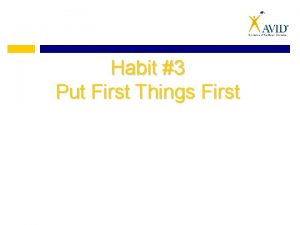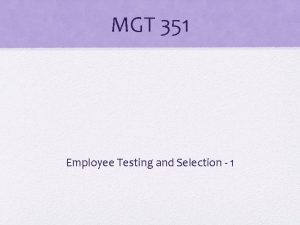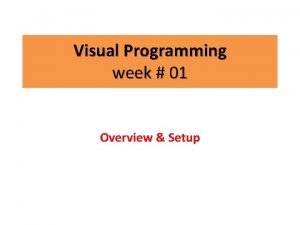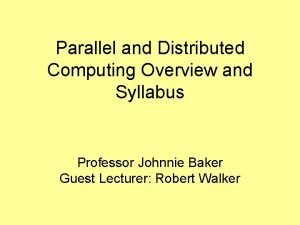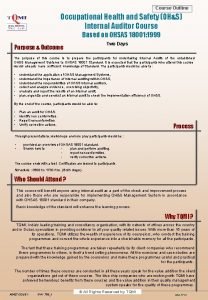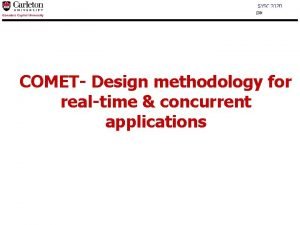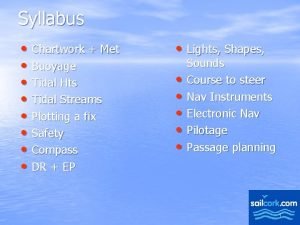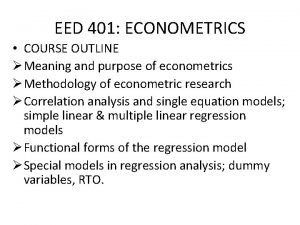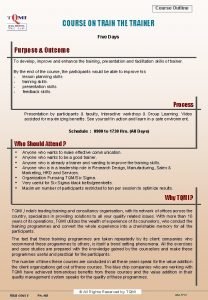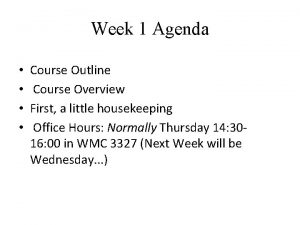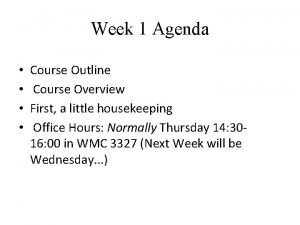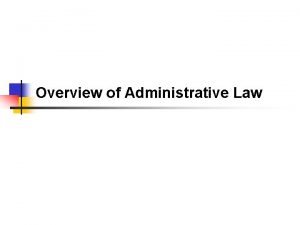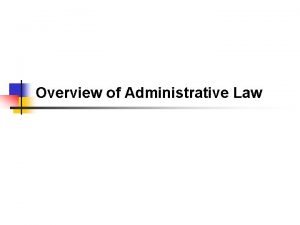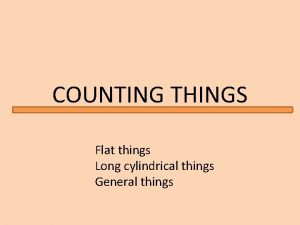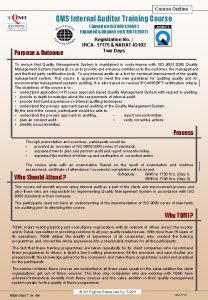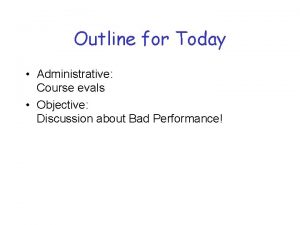1 Outline First things first Administrative overview Course

































- Slides: 33

1

Outline First things first Administrative overview Course non-goals Course goals Key problems Network performance concepts 1 CMU CS 15 -441

First Things First Please read Chapter 1 of the text Also, please remind me to let you stretch � 1 I haven't taught a 80 -minute class in ~5 years CMU CS 15 -441

People Professors � Hui Zhang (www. cs/~hzhang) � Dave Eckhardt (www. cs/~davide) Teaching assistants � Pratyusa Manadhata � Shafeeq Sinnamohideen � Aditya Ganjam � Arvind Kannan Course secretary � 1 Kathy Mc. Niff, Wean Hall 7112 CMU CS 15 -441

Information Sources Watch the course web page � http: //www. cs. cmu. edu/~441 � We expect you to read the syllabus! � Handouts, readings, . . We expect you to read course bboards � Official announcements � � Questions/answers � 1 academic. cs. 15 -441. announce academic. cs. 15 -441 CMU CS 15 -441

Information Sources Textbook � 1 Peterson and Davie, Computer Networks: A Systems Approach, 3 rd Edition, Morgan Kaufmann, 2003 CMU CS 15 -441

Information Sources ~30 lectures 3 paper homeworks 2 lab homeworks � Illustrate networking concepts Mid-term and final 1 programming assignment � How to use a network 2 programming projects � 1 How to build a network CMU CS 15 -441

Grading Deadline means deadline � 1 Deadline is 11: 59 pm on the specified date CMU CS 15 -441

Policy on Collaboration Working together is important � Discuss course material in general terms � Talk over tough debugging problems Parts of the course must be done individually � Homeworks, midterm, final, 1 st programming assignment Projects are done by two-student teams � Learn how to collaborate � But each student should understand the entire project! Web page has the details 1 CMU CS 15 -441

Course Non-goals Learn how to configure a Cisco router � That requires a class all by itself � Cisco teaches those classes � Our perspective will be broader Become “Internet Experts” 1 � The Internet will be our frequent motivating example � Our perspective will be broader CMU CS 15 -441

Why not an “Internet class”? Is there anything else? � Philosophy final exam question � Define “Universe”. Give two examples. Yes – Internet in the 1800's! Yes – The secret network? [Yes – What's next? ] 1 CMU CS 15 -441

Internet in the 1800's!? ! Tom Standage, The Victorian Internet � Telegraph! � Continent-spanning systems � Digital transmission of information � Nerds � Attacks on the moral fiber of society � On-line dating (even a wedding!) Distributed message routing despite link outages � Lines cut by armies in wartime! Many problems, solutions eerily similar 1 CMU CS 15 -441

The Secret Network With the Internet, who needs the phone system? � It's a “new era”, etc. One small detail. . . � From inception, Internet has been a phone system application! � To connect two nodes, just ask your telco for a “circuit”. . . � 1 � . . . somehow there's always copper/fiber waiting for you. . . � . . . somehow when it breaks it gets fixed fast. . . � . . . somehow your circuit can terminate anywhere. . . Somehow? CMU CS 15 -441

Course Goals Think “the network way” � Distributed coordination is hard, let's go shopping Learn how computer networks work � Problems, approaches, protocols, software Learn how to write network applications Hands-on understanding of network internals � 1 Build a simple network in software CMU CS 15 -441

Selected Key Problems Two Generals Group Membership Scaling 1 CMU CS 15 -441

Two Generals Problem (formulated by Jim Gray? ) � � Two cooperating armies � Each size 2 X � Separated by. . . One opposing army � Size 3 X Idealized “combat” 1 � 4 X vs. 3 X: win � 2 X vs. 3 X: lose CMU CS 15 -441

Two Generals Problem � � Two cooperating armies � Each size 2 X � Separated by. . . One opposing army � Size 3 X Idealized “combat” 1 � 4 X vs. 3 X: win � 2 X vs. 3 X: lose CMU CS 15 -441

Two Generals 1 CMU CS 15 -441

Two Generals Necessity: coordinated attack � Armies can communicate via messenger Protocol 0 � C: “Attack at dawn!” � What if C's messenger is captured by C++? Protocol 1 � C: “Attack at dawn! Ok? ” � ML: “Ok!” � What if ML's messenger is captured? Seemingly-simple coordination is impossible! 1 CMU CS 15 -441

Group Membership Group of nodes on a network � Require distributed election of a “leader” Sample solution � � “Dstributed election” algorithm chooses among group members If a node enters or leaves during election, re-start algorithm Results 1 � Works great for 10 nodes � Fails horribly for 1, 000 nodes � If inter-join time approximates election time. . . � Election process never completes CMU CS 15 -441

Group Membership Problem: “group membership” is undefined � By the time you can compute it, it's changed Lots of algorithms will run into trouble � “To acquire a node number, add one to the largest current node number” – oops! Key network functions must face this environment � 1 Routing, naming CMU CS 15 -441

Scaling “DOD Standard Internet Protocol” � � RFC 760, 1980: Addresses are fixed length of four octets (32 bits). An address begins with a one octet network number, followed by a three octet local address. This three octet field is called the "rest" field. 254 networks (too many to count!) Subsequently revised to Class A/B/C networks � ~16 k “Class B” networks of ~64 k hosts (CMU) � ~4 m “Class C” networks of ~255 hosts Then “subnets”, then “CIDR” “Too many to count” evaporates pretty fast! 1 CMU CS 15 -441

Network Performance Concepts Throughput � “How many things per unit time? ” � Mb/s = megabits per second � KB/s = kilobytes per second Latency � � “How long until my message arrives? ” � ms = millisecond (10 -6), µs = microsecond (10 -9) Reciprocal “in theory” � � 1 bits/second = (1/(seconds/bit)) Relationship much more complex CMU CS 15 -441

Hen Performance Old riddle � “If a hen and a half lays an egg and a half in a day and a half, how long does it take to get a dozen eggs? ” Egg Latency � How long does it take for one hen to lay one egg? Henhouse throughput (eggs per day) 1 � Increases with number of hens � Does not mean you can build henhouse, get first egg in 1 hour � What is minimum time to 12 eggs? CMU CS 15 -441

Latency and Throughput Radio a message to your friend Mike 1 � 1 -megabyte photo � 1 -megabit radio link � How long? CMU CS 15 -441

Two Problems Small problem � Mega != mega � Computer people: megabyte = 220 bytes � Network people: megabit = 106 bits � It's 8. 4 seconds, not 8 Big problem � I forgot to tell you. . . Mike lives on the moon � � 1 (Extra credit: What is Mike's last name? ) It takes radio waves 1. 3 seconds to get there CMU CS 15 -441

Message Latency Message latency = sum of � propagation delay (distance/lightspeed) � transmission time (size/throughput) � queue delay (ignore for now) Message to Mike � propagation delay is 1. 3 seconds (one-way) � � also known as “link delay” transmission time is 8. 4 seconds, total is 9. 7 (121% of 8) By the way: RTT (round-trip-time) � 1 Time to send a 0 -bit message there and back: 2. 6 seconds CMU CS 15 -441

Message Latency Propagation delay vs. transmission time � May vary widely � Earth-to-Moon is 1. 3 seconds (<< 9. 7) � Delay is a minor compared to transmission time � Can transmit part of message, receive back status � � 1 “Got that part ok” or “Oops, send it again” Earth-to-Mars is 300 -1225 seconds (>> 9. 7) � Delay vastly exceeds transmission time � Link holds multiple entire messages CMU CS 15 -441

Latency and Throughput Bandwidth-delay product � megabits/second X link-delay � This many bits are always “in flight” / “queued in link” What if Mike says “Stop!! My buffer is full!”? � One b-d product of bits are “in flight” to him already � You will queue another b-d product before you hear his alert! Message throughput ( link throughput) 1 � How many messages per second can you send to Mike? � Depends on b-d product vs. message size � Depends on message protocol (= waiting protocol) you use CMU CS 15 -441

Latency and Throughput See text for more-dignified treatment � No hens, no Martians Things to watch out for 1 � Is “delay” one-way or round-trip? � Mega vs. mega, kilo vs. kilo � Do we mean link latency or message latency? � Do we mean link throughput or message throughput? CMU CS 15 -441

Things Which Aren't Throughput Bandwidth � � � Properly, measured in Hertz Difference between max & min frequency of transmission band Routinely abused by CS people to mean “throughput” Goodput � � 1 Used to mean “productive throughput” Ignore “waste” if part of a message is transmitted multiple times CMU CS 15 -441

Back to the Internet Another reason the Internet isn't perfect � Fatally overoptimized for single-planet case � Will work to low-Earth orbit � Efficiency problems talking to the Moon � Forget about Mars Inter. Planetary Internet � 1 http: //www. ipnsig. org/ CMU CS 15 -441

Summary First things first � Read Chapter 1 � Study socket-programming example as a refresher Project 1 (individual) out Wednesday Course non-goals, goals � “Networking perspective”, Internet as running example Key problems � Distributed coordination; scaling Network performance concepts � 1 Throughput vs. latency, . . . CMU CS 15 -441
 Maturity continuum examples
Maturity continuum examples Habit 3 lesson plans
Habit 3 lesson plans Habit 3
Habit 3 Put first things first definition
Put first things first definition See do get model
See do get model Habit 3 put first things first
Habit 3 put first things first Put first things first video
Put first things first video Habit 3 activities
Habit 3 activities Put first things first
Put first things first Sandwich quote example
Sandwich quote example Social psychology outline
Social psychology outline Mgt 351 nsu course outline
Mgt 351 nsu course outline Geo 702 ryerson
Geo 702 ryerson Occupational health and safety assessment series
Occupational health and safety assessment series Ai2.appinventor.mit.edu emulator
Ai2.appinventor.mit.edu emulator Parallel and distributed computing course outline
Parallel and distributed computing course outline Java course outline
Java course outline Knowledge management course outline
Knowledge management course outline Bsb51407
Bsb51407 Syllabus in curriculum development
Syllabus in curriculum development Occupational health and safety course outline
Occupational health and safety course outline Nisan langberg
Nisan langberg Phys1160 course outline
Phys1160 course outline Sysc 2004 course outline
Sysc 2004 course outline Hts course outline
Hts course outline Recruitment selection and placement process
Recruitment selection and placement process Course outline meaning
Course outline meaning Train the trainer outline
Train the trainer outline Agile course outline
Agile course outline Functional english course outline
Functional english course outline American literature course outline
American literature course outline Analytical thinking training course outline
Analytical thinking training course outline Rhcsa course outline
Rhcsa course outline Molecular biology course outline
Molecular biology course outline






